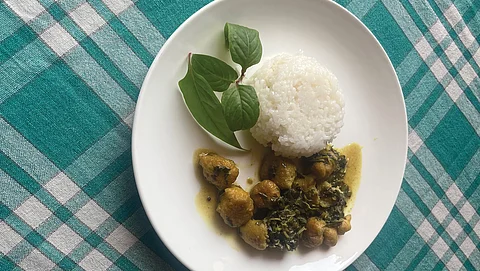

It might be a weed, but it is quite tasty. The leaves of madhu soleng, as the Chinese knotweed is known in Assamese, taste sour. Raw leaves are generally used to prepare salads, but creative cooks can put them in dal, curries, chutney and even pickle them.
The leaves can be stored for four to five days. The plant also bears berries that taste sour. Its flowers and seeds are edible, too, but are merely available for a few days in the monsoon season. “I would recommend it as a souring agent because it is an anti-inflammatory herb and great for gut health,” says Sangeeta Khanna, a Delhi-based food and nutrition expert, who usually adds madhu soleng leaves to dal instead of tomatoes or raw mangoes. She also uses them to prepare fish tenga, a traditional Assamese dish.
Madhu soleng (Persicaria chinensis, which loosely translates to “the plant from China which has leaves like that of peach”) is generally considered invasive. In tea plantations, it has been reported to cover tea bushes and block drainage systems. It has been spotted even in protected areas such as the Kaas plateau reserve forest in Maharashtra, which is famous for the flower neelakurinji (Strobilanthes kunthiana) that blooms once in 12 years.
It is a twining perennial herb that grows to a height of 1 m and has a reddish stem. It grows easily in various parts of India and adapts well in most areas—from those at the sea level to those at an elevation of 3,000 meters. It is known as angom yensil in Manipuri, paral in Marathi, poovallikodi in Malayalam, sorale in Kannada, malle mutyam in Telugu and taham in Mizo.
Due to its invasive nature, madhu soleng is an easy plant to grow and a valuable ingredient in a climate-risked world. The weed grows fast and can tolerate diverse environmental conditions, says The Global Compendium of Weeds, authored by R P Randall and published in 2002. It can spread by seed or through stems.
Khanna says that the weed is growing robustly in her garden since she got the plant from Assam a few years ago. I got a few twigs from Khanna's garden, put them in a flower vase and found them thriving a week later, with clearly visible little rootlets. I used them to prepare a sauce for a dal-based dish (see recipe).
Ingredients
Split red lentils: ½ cup
Madhu soleng leaves: 2 cups (chopped)
Turmeric powder: ½ tsp
Mustard seeds: ½ tsp
Whole red chilli: 1
Garlic: 4-5 cloves
Salt to taste
Oil to fry the pakodas
Pinch of sugar
Method
Wash and soak the lentils for 2 to 3 hours. Drain the water and grind the lentils, adding salt and chilli. Heat the oil in a pan and fry the pakodas. In another pan, heat a little bit of mustard oil and add mustard seeds, garlic, turmeric powder, chilli and salt. Add the washed and chopped madhu soleng leaves. Add a pinch of sugar and cook for 5 minutes. Add a glass of water and bring to a boil. Add the pakodas to this gravy and cook for a few minutes. Serve with white rice.
Ingredients
Rohu fish: 6 pieces
Madhu soleng leaves (chopped): 1 cup
Green chillies: 3 to 4
Fenugreek seeds: ½ tsp
Mustard seeds: ½ tsp
Turmeric powder: 1 tsp
Salt to taste
Mustard oil 1 cup
Method
Wash the fish pieces and add turmeric and salt. Mix them well and set aside for 15 minutes. Add oil in a frying pan and fry the fish on both sides till the skin is crisp and brown. For the curry, heat
2 tbsp mustard oil (the leftover oil from frying the fish can be used) in a pan and splutter fenugreek and mustard seeds in it. Add the onions and chillies followed by madhu soleng leaves and cook for a few minutes. Add a cup of water and the fish pieces and let it cook till the gravy is thick. Enjoy with rice.
The leaves of madhu soleng have multiple medicinal uses. They are consumed to treat scurvy and for healing wounds. In Malnad region of Karnataka, the tender leaves are eaten to control seasonal ailments such as indigestion, common flu and cold during monsoons.
In traditional Chinese medicine systems, an extract of the leaves is used externally to treat eczema of the ears and for treating eye diseases. A poultice of leaves is often applied to the abdomen for alleviating stomach pain. A decoction of the dried leaves is said to treat boils and dysentery. Even snake-bites are believed to be cured by an oral administration of the juice of fresh leaves while the mashed residue is applied to the bite as a plaster Researchers from South Korea and Bangladesh investigated the inhibitory mechanism and the proteins responsible for the anti-inflammatory responses of the plant by studying its methanolic extract. In mice models, they induced gastritis with the help of chemicals. When these mice were given the methanolic extract, the increase of anti-inflammatory activity could be seen. The authors say that this methanolic extract subdues enzymes Syk and Src kinases which activate the NF-KB signaling pathway that leads to inflammation and immune responses. The findings were published in the Journal of Ethnopharmacology in 2015.
In another study, researchers from the Botanical Survey of India evaluated the antioxidant and hydrogen peroxide-induced DNA damage protection activity of five wild plants including madhu soleng to provide scientific basis for traditional usage of this plant. They found that water ex-tract of Persicaria had p-coumaric acid and ferulic acid, and could inhibit DNA damage, states the study published in Food Chemistry Advances in 2022.
This article was originally published in the June 1-15, 2025 print edition of Down To Earth